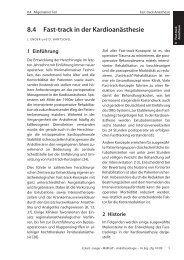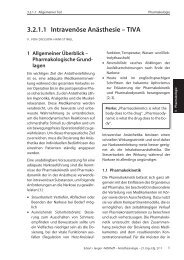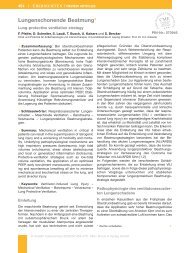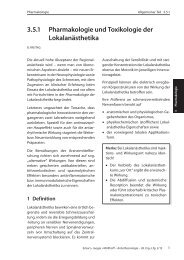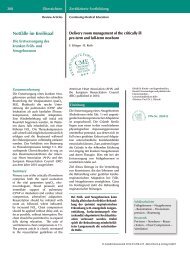Lokalanästhetika-Toxizität
Lokalanästhetika-Toxizität
Lokalanästhetika-Toxizität
Sie wollen auch ein ePaper? Erhöhen Sie die Reichweite Ihrer Titel.
YUMPU macht aus Druck-PDFs automatisch weboptimierte ePaper, die Google liebt.
196 Übersichten<br />
18. Harvey M, Cave G, Prince G, Lahner<br />
D. Epinephrine injection in lipid-based<br />
resuscitation from bupivacaine-induced<br />
cardiac arrest: transient circulatory return<br />
in rabbits. Anesth Analg 2010;111(3):<br />
791-6.<br />
19. Hicks SD, Salcido DD, Logue ES,<br />
Suffoletto BP, Empey PE, Poloyac SM,<br />
Miller DR, Callaway CW, Menegazzi JJ.<br />
Lipid emulsion combined with epinephrine<br />
and vasopressin does not improve<br />
survival in a swine model of bupivacaineinduced<br />
cardiac arrest. Anesthesiology<br />
2009;111(1):138-46.<br />
20. Hille B. Common mode of action of three<br />
agents that decrease the transient change<br />
in sodium permeability in nerves. Nature<br />
1966;210(5042):1220-2.<br />
21. Hille B. Local anesthetics: hydrophilic<br />
and hydrophobic pathways for the<br />
drug-receptor reaction. J Gen Physiol<br />
1977;69(4):497-515.<br />
22. Hiller DB, Gregorio GD, Ripper R, Kelly K,<br />
Massad M, Edelman L, Edelman G,<br />
Feinstein DL, Weinberg GL. Epinephrine<br />
impairs lipid resuscitation from bupivacaine<br />
overdose: a threshold effect.<br />
Anesthesiology 2009;111(3):498-505.<br />
23. Hübler M, Koch T. Komplikationen in<br />
der Anästhesie. 2010, Springer: Berlin,<br />
Heidelberg. p. 231.<br />
24. Ito H, Ibaraki M, Kanno I, Fukuda H, Miura<br />
S. Changes in the arterial fraction of human<br />
cerebral blood volume during hypercapnia<br />
and hypocapnia measured by positron<br />
emission tomography. J Cereb Blood Flow<br />
Metab 2005;25(7):852-7.<br />
25. Kendig JJ. Clinical implications of the<br />
modulated receptor hypothesis: local<br />
anes thetics and the heart. Anesthesiology.<br />
1985;62(4):382-4.<br />
26. Klein SM, Pierce T, Rubin Y, Nielsen KC,<br />
Steele SM. Successful resuscitation after<br />
ropivacaine-induced ventricular fi brillation.<br />
Anesth Analg 2003;97(3):901-3.<br />
27. Koster RW, Baubin MA, Bossaert LL,<br />
Caballero A, Cassan P, Castren M, Granja<br />
C, Handley AJ, Monsieurs KG, Perkins<br />
GD, Raffay V, Sandroni C. European<br />
Resuscitation Council Guidelines for<br />
Resuscitation 2010 Section 2. Adult<br />
basic life support and use of automated<br />
external defi brillators. Resuscitation<br />
2010;81(10):1277-92.<br />
28. Kotelko DM, Shnider SM, Dailey PA,<br />
Brizgys RV, Levinson G, Shapiro WA, Koike<br />
M, Rosen MA. Bupivacaine-induced cardiac<br />
arrhythmias in sheep. Anesthesiology<br />
1984;60(1):10-8.<br />
29. Levsky ME, Miller MA. Cardiovascular<br />
collapse from low dose bupivacaine. Can J<br />
Clin Pharmacol 2005;12(3):240-5.<br />
30. Litz RJ, Popp M, Stehr SN, Koch T.<br />
Successful resuscitation of a patient<br />
with ropivacaine-induced asystole after<br />
Zertifi zierte Fortbildung<br />
Review Articles Continuing Medical Education<br />
axillary plexus block using lipid infusion.<br />
Anaesthesia 2006;61(8):800-1.<br />
31. Ludot H, Tharin JY, Belouadah M, Mazoit<br />
JX, Malinovsky JM. Successful resuscitation<br />
after ropivacaine and lidocaine-induced<br />
ventricular arrhythmia following posterior<br />
lumbar plexus block in a child. Anesth<br />
Analg 2008;106(5):1572-4.<br />
32. Marwick PC, Levin AI, Coetzee AR.<br />
Recurrence of cardiotoxicity after lipid<br />
rescue from bupivacaine-induced cardiac<br />
arrest. Anesth Analg 2009;108(4):1344-6.<br />
33. Mather LE, Chang DH. Cardiotoxicity with<br />
modern local anaesthetics: is there a safer<br />
choice? Drugs 2001;61(3):333-42.<br />
34. Mayr VD, Mitterschiffthaler L, Neurauter<br />
A, Gritsch C, Wenzel V, Muller T, Luckner<br />
G, Lindner KH, Strohmenger HU. A comparison<br />
of the combination of epinephrine<br />
and vasopressin with lipid emulsion in a<br />
porcine model of asphyxial cardiac arrest<br />
after intravenous injection of bupivacaine.<br />
Anesth Analg 2008;106(5):1566-71.<br />
35. Mazoit JX, Le Guen R, Beloeil H,<br />
Benhamou D. Binding of long-lasting<br />
local anesthetics to lipid emulsions.<br />
Anesthesiology 2009;110(2):380-6.<br />
36. Moore DC, Thompson GE, Crawford RD.<br />
Long-acting local anesthetic drugs and<br />
convulsions with hypoxia and acidosis.<br />
Anesthesiology 1982;56(3):230-2.<br />
37. Mulroy MF. Local anesthetics: helpful<br />
science, but don‘t forget the basic<br />
clinical safety steps. Reg Anesth Pain Med<br />
2005;30(6):513-5.<br />
38. Neal JM, Bernards CM, Butterworth JFt, Di<br />
Gregorio G, Drasner K, Hejtmanek MR,<br />
Mulroy MF, Rosenquist RW, Weinberg GL.<br />
ASRA practice advisory on local anesthetic<br />
systemic toxicity. Reg Anesth Pain Med<br />
2010;35(2):152-61.<br />
39. Nolan JP, Soar J, Zideman DA, Biarent D,<br />
Bossaert LL, Deakin C, Koster RW, Wyllie J,<br />
Böttiger B. European Resuscitation Council<br />
Guidelines for Resuscitation 2010 Section<br />
1. Executive summary. Resuscitation<br />
2010;81(10):1219-76.<br />
40. Rosenblatt MA, Abel M, Fischer GW,<br />
Itzkovich CJ, Eisenkraft JB. Successful use<br />
of a 20% lipid emulsion to resuscitate a<br />
patient after a presumed bupivacainerelated<br />
cardiac arrest. Anesthesiology<br />
2006;105(1):217-8.<br />
41. Salomaki TE, Laurila PA, Ville J. Successful<br />
resuscitation after cardiovascular collapse<br />
following accidental intravenous infusion<br />
of levobupivacaine during general anesthesia.<br />
Anesthesiology 2005;103(5):1095-6.<br />
42. Scott DB. Toxicity caused by local an aes -<br />
thetic drugs. Br J Anaesth 1981;53(6):<br />
553-4.<br />
43. Soar J, Perkins GD, Abbas G, Alfonzo A,<br />
Barelli A, Bierens JJ, Brugger H, Deakin<br />
CD, Dunning J, Georgiou M, Handley<br />
AJ, Lockey DJ, Paal P, Sandroni C, Thies<br />
KC, Zideman DA, Nolan JP. European<br />
Resuscitation Council Guidelines for<br />
Resuscitation 2010 Section 8. Cardiac<br />
arrest in special circumstances: Electrolyte<br />
abnormalities, poisoning, drowning, accidental<br />
hypothermia, hyperthermia, asthma,<br />
anaphylaxis, cardiac surgery, trauma,<br />
pregnancy, electrocution. Resuscitation<br />
2010;81(10):1400-33.<br />
44. Strichartz G. Molecular mechanisms<br />
of nerve block by local anesthetics.<br />
Anesthesiology 1976;45(4):421-41.<br />
45. Sztark F, Malgat M, Dabadie P, Mazat JP.<br />
Comparison of the effects of bupivacaine<br />
and ropivacaine on heart cell mitochondrial<br />
bioenergetics. Anesthesiology<br />
1998;88(5):1340-9.<br />
46. Volk T, Graf B, Gogarten W, Kessler P, Wulf<br />
H. Empfehlungen zur Lipidbehandlung<br />
bei der Intoxikation mit <strong>Lokalanästhetika</strong>.<br />
Anästh Intensivmed 2009;50:698-702.<br />
47. Warren JA, Thoma RB, Georgescu A,<br />
Shah SJ. Intravenous lipid infusion in the<br />
successful resuscitation of local anestheticinduced<br />
cardiovascular collapse after<br />
supraclavicular brachial plexus block.<br />
Anesth Analg 2008;106 (5):1578-80.<br />
48. Weinberg G, Ripper R, Feinstein DL,<br />
Hoffman W. Lipid emulsion infusion<br />
rescues dogs from bupivacaine-induced<br />
cardiac toxicity. Reg Anesth Pain Med<br />
2003;28(3):198-202.<br />
49. Weinberg GL, Ripper R, Murphy P,<br />
Edelman LB, Hoffman W, Strichartz G,<br />
Feinstein DL. Lipid infusion accelerates<br />
removal of bupivacaine and recovery<br />
from bupivacaine toxicity in the<br />
isolated rat heart. Reg Anesth Pain Med<br />
2006;31(4):296-303.<br />
50. Zausig YA, Zink W, Keil M, Sinner B,<br />
Barwing J, Wiese CH, Graf BM. Lipid<br />
emulsion improves recovery from<br />
bupivacaine-induced cardiac arrest, but<br />
not from ropivacaine- or mepivacaineinduced<br />
cardiac arrest. Anesth Analg<br />
2009;109(4):1323-6.<br />
Korrespondenzadresse<br />
Dr. med.<br />
Heiko Baumann<br />
D.E.S.A.<br />
Klinik für Anaesthesie und<br />
Operative Intensivmedizin<br />
St. Vincentius-Kliniken gAG<br />
Steinhäuserstraße 18<br />
76135 Karlsruhe, Deutschland<br />
E-Mail:<br />
heiko.baumann@vincentius-ka.de<br />
© Anästh Intensivmed 2011;52:189-198 Aktiv Druck & Verlag GmbH



